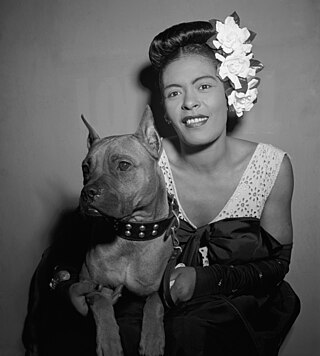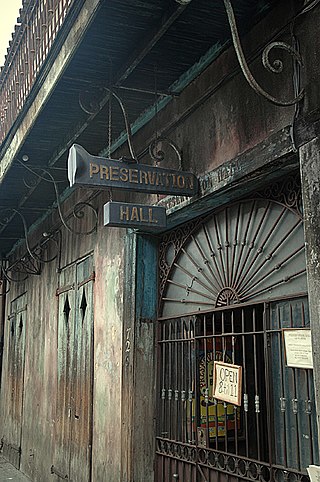
Ferdinand Joseph LaMothe, known professionally as Jelly Roll Morton, was an American ragtime and jazz pianist, bandleader, and composer of Louisiana Creole descent. Morton was jazz's first arranger, proving that a genre rooted in improvisation could retain its essential characteristics when notated. His composition "Jelly Roll Blues", published in 1915, was one of the first published jazz compositions. He also claimed to have invented the genre.

Billie Holiday was an American jazz and swing music singer. Nicknamed "Lady Day" by her friend and music partner, Lester Young, Holiday made a significant contribution to jazz music and pop singing. Her vocal style, strongly influenced by jazz instrumentalists, inspired a new way of manipulating phrasing and tempo. She was known for her vocal delivery and improvisational skills.

Gertrude "Ma" Rainey was an American blues singer and influential early-blues recording artist. Dubbed the "Mother of the Blues", she bridged earlier vaudeville and the authentic expression of southern blues, influencing a generation of blues singers. Rainey was known for her powerful vocal abilities, energetic disposition, majestic phrasing, and a "moaning" style of singing. Her qualities are present and most evident in her early recordings "Bo-Weevil Blues" and "Moonshine Blues".

Lady Sings the Blues is a 1972 American biographical musical drama film directed by Sidney J. Furie about jazz singer Billie Holiday, loosely based on her 1956 autobiography which, in turn, took its title from Holiday's song. It was produced by Motown Productions for Paramount Pictures. Diana Ross, in her feature film debut, portrayed Holiday, alongside a cast including Billy Dee Williams, Richard Pryor, James T. Callahan, and Scatman Crothers. The film was nominated for five Academy Awards in 1973, including Best Actress for Diana Ross.

George Lewis was an American jazz clarinetist who achieved his highest profile in the later decades of his life.

Sippie Wallace was an American blues singer, pianist and songwriter. Her early career in tent shows gained her the billing "The Texas Nightingale". Between 1923 and 1927, she recorded over 40 songs for Okeh Records, many written by her or her brothers, George and Hersal Thomas. Her accompanists included Louis Armstrong, Johnny Dodds, Sidney Bechet, King Oliver, and Clarence Williams. Among the top female blues vocalists of her era, Wallace ranked with Ma Rainey, Ida Cox, Alberta Hunter, and Bessie Smith.

Christiern Gunnar Albertson was a New York City-based jazz journalist, writer and record producer.

Preservation Hall is a jazz venue on St Peter Street in the French Quarter of New Orleans, Louisiana. The building is associated with a house band, a record label, and a non-profit foundation.

The Preservation Hall Jazz Band is a New Orleans jazz band founded in New Orleans by tuba player Allan Jaffe in the early 1960s. The band derives its name from Preservation Hall in the French Quarter. In 2005, the Hall's doors were closed for a period of time due to Hurricane Katrina, but the band continued to tour.

Ernestine Anderson was an American jazz and blues singer. In a career spanning more than six decades, she recorded over 30 albums. She was nominated four times for a Grammy Award. She sang at Carnegie Hall, the Kennedy Center, the Monterey Jazz Festival, as well as at jazz festivals all over the world. In the early 1990s she joined Qwest Records, the label founded by fellow Garfield High School graduate Quincy Jones.

Louis Hall Nelson was an American jazz trombonist.

Lars Ivar Edegran is a Dixieland jazz musician and bandleader from Sweden. He most often plays piano, guitar, or banjo but has also played mandolin, clarinet, and saxophone.

Alcide Louis "Slow Drag" Pavageau was an American jazz double bassist and guitarist.

Allan Phillip Jaffe was an American jazz tubist and the entrepreneur who, along with his wife Sandra, developed Preservation Hall into a New Orleans jazz tradition.

Ida Goodson was an American classic female blues and jazz singer and pianist.

Joseph De Lacroix "De De" Pierce was an American jazz trumpeter and cornetist. He is best remembered for the songs "Peanut Vendor" and "Dippermouth Blues", both with Billie Pierce.
Shannon Powell is an American jazz and ragtime drummer. He has toured internationally and played with Ellis Marsalis, Harry Connick, Jr., Danny Barker, Branford Marsalis, Wynton Marsalis and the Lincoln Center Jazz Orchestra, Diana Krall, Earl King, Dr. John, Preservation Hall, Marcus Roberts, John Scofield, Jason Marsalis, Leroy Jones, Nicholas Payton, and Donald Harrison Jr. Powell toured and recorded with fellow New Orleans native, Harry Connick Jr.
Women in jazz have contributed throughout the many eras of jazz history, both as performers and as composers, songwriters and bandleaders. While women such as Billie Holiday and Ella Fitzgerald were famous for their jazz singing, women have achieved much less recognition for their contributions as composers, bandleaders and instrumental performers. Other notable jazz women include piano player Lil Hardin Armstrong and jazz songwriters Irene Higginbotham and Dorothy Fields.
Alexander Louis Bigard, Jr. was an American jazz drummer. He was the brother of Barney Bigard and a cousin of Natty Dominique and A.J. Piron, and was involved for decades with the New Orleans jazz scene.

Dave Albert Williams Jr. was an American jazz, blues, and rhythm & blues pianist, bandleader, singer, and songwriter. He was the author of "I Ate Up The Apple Tree", a staple of contemporary New Orleans brass bands. His career as a working musician spanned five decades.


















